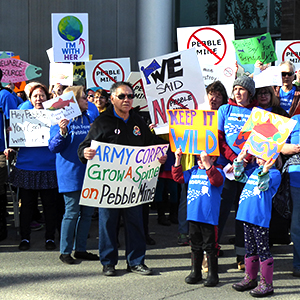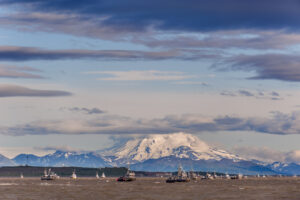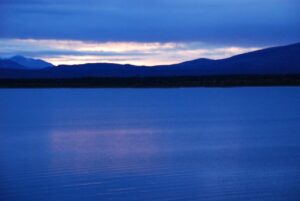
Science debunks Army Corps’ Pebble conclusions
This is the first of a series of stories Trustees will post on the scientific flaws and omission in the Army Corps of Engineer’s draft environmental impact statement for the proposed Pebble mine—a project the majority of Alaskans oppose.

Fishing Bristol Bay. Photo by Carl Johnson.
Last week, the U.S. Army Corps of Engineers released its draft environmental impact statement for the proposed Pebble mine.
Pebble intends to put a massive mine at the headwaters of the Bristol Bay watershed and a thriving salmon fishery that provides food, jobs, and the social and cultural foundations of dozens of communities.
The Pebble Partnership and its parent company, Northern Dynasty of Canada, claim that the Army Corps’ draft EIS shows that mining company can produce an enormous toxic waste hazard that will exist for thousands of years without threatening fish, water and Alaska communities.
Science and traditional knowledge say otherwise.
In fact, scientists will release a dam failure model on Friday, March 1, in Anchorage, Alaska that will show the devastation of a dam failure and an avalanche of toxic mine waste on Bristol Bay.
 Truth is, the Army Corps draft EIS released on Feb. 20 discards sound science on every level and fails to address and respect the public concerns aired by the people of Alaska and Bristol Bay for over a decade.
Truth is, the Army Corps draft EIS released on Feb. 20 discards sound science on every level and fails to address and respect the public concerns aired by the people of Alaska and Bristol Bay for over a decade.
A forever home for salmon and Alaska communities
Right now Bristol Bay supports dozens of Alaska communities that rely on the area’s fisheries for work, food, culture and their ways of life. The area nourishes record-breaking salmon runs that feed people and produce thousands of Alaska job.
Indigenous people have eaten salmon and used it as the foundation of their culture for thousands of year.
Yet the Pebble proposal aims to throw thousands of years of stewardship out the window, just as the Army Corps’ conclusions toss out the best science—the Environmental Protection Agency’s 2014 Bristol Bay Watershed Assessment.
The twice peer-reviewed scientific report that came out in 2014 concluded that a mine in Bristol Bay could harm the cultures, fisheries and economies of the region even without a catastrophic failure.

Salmon is a key food in Bristol Bay. Photo by © Carl Johnson.
Truth is, the Watershed Assessment is the best, most thorough, most reviewed and most unanimous science on the subject, yet the Army Corps dismisses that report’s conclusions in order to give corporate and political interests the permit outcomes they want.
Army Corps draft EIS full of holes
The Army Corps draft EIS all but ignores the Watershed Assessment. It fails to show that that assessment is inaccurate or that its conclusions are unfounded.
Moreover, the draft EIS further does not look at the full nature and extent of the impacts of a mine on Bristol Bay, and even overlooks the potential outcomes of a wastewater tailings dam failure,
This year’s recent dam failure in Brazil that killed hundreds of people shows what can happen when dams that “meet the standards” one month devastate communities a few months down the road.
Pebble’s talking points rely on buzzwords and hubris to boost untested innovations and unfounded claims of safe operations while disrespecting the human rights of people who can only survive if their water is clean, and their fish healthy.
It’s the water, stupid

Clean water lets healthy salmon thrive. Photo by Brian Litmans.
Water defines how people move from place to place in Bristol Bay. It flows through the region’s social, cultural and fiscal economies. Water is the source for food, and the place where people gather at fish camps, or drop their nets and throw their lines.
Protecting Bristol Bay means protecting water, and that’s what the proposed Pebble mine cannot do.
U.S. copper mines take huge amounts of water from the natural system. They have huge impacts on water quantity and quality.
A 2012 report shows that over 90 percent of 14 currently operating mines failed to capture or treat toxic wastewater seepage that can kills and harm fish, animals, waterways, and people.
Yet, the Pebble proposal requires that it treat more wastewater than any other operating mine in the U.S.–and that it does so with a promise and prayer that it can protect the waterway from toxic sludge FOREVER.
Massive toxic hazards do not belong near thriving waterways
Outside corporate interests want to put a massive open pit mine that requires massive hazardous wastewater storage for thousands of years on Alaska’s—and the world’s—most thriving salmon fishery.
The proposal is arrogant hubris at best.
If the agencies charged with protecting our water, land, fish and wildlife, including indigenous ways of life that rely on salmon and other animals for food, stand idly by and grease the wheels for Pebble’s pocketbook while claiming innocence through process, then let us call it out for what it is. Complicity.
Public hearings on the draft EIS are currently slated for late March and early April in nine communities. The Army Corps will begin a 90-day public comment period on March 1.
Stay tuned for future articles on how to participate in the public process, and what science tells us about the draft EIS.


